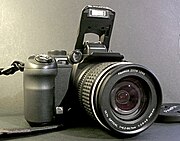
A digital camera is a camera that takes video or still photographs, or both, digitally by recording images on a light-sensitive sensor.
Many compact digital still cameras can record sound and moving video as well as still photographs. In the Western market, digital cameras outsell their 35 mm film counterparts.
Digital cameras can include features that are not found in film cameras, such as displaying an image on the camera's screen immediately after it is recorded, the capacity to take thousands of images on a single small memory device, the ability to record video with sound, the ability to edit images, and deletion of images allowing re-use of the storage they occupied.
Digital cameras are incorporated into many devices ranging from PDAs and mobile phones (called camera phones) to vehicles. The Hubble Space Telescope and other astronomical devices are essentially specialised digital cameras.
Classification
Digital cameras can be classified into several categories:
Compact digital cameras
Compact cameras are designed to be small and portable; the smallest are described as subcompacts or "ultra-compacts". Compact cameras are usually designed to be easy to use, sacrificing advanced features and picture quality for compactness and simplicity; images can usually only be stored using Lossy compression (JPEG). Most have a built-in flash usually of low power, sufficient for nearby subjects. Live preview is almost always used to frame the photo. They may have limited motion picture capability. Compacts often have macro capability, but if they have zoom capability the range is usually less than for bridge and DSLR cameras. They have a greater depth of field, allowing objects within a large range of distances from the camera to be in sharp focus. They are particularly suitable for casual and "snapshot" use.
Bridge cameras
Bridge or SLR-like cameras are higher-end digital cameras that physically resemble DSLRs and share with them some advanced features, but share with compacts the framing of the photo using live preview and small sensor sizes.
Bridge cameras often have superzoom lenses which provide a very wide zoom range, typically between 10:1 and 18:1, which is attained at the cost of some distortions, including barrel and pincushion distortion, to a degree which varies with lens quality. These cameras are sometimes marketed as and confused with digital SLR cameras since the appearance is similar. Bridge cameras lack the mirror and reflex system of DSLRs, have so far been fitted with fixed (non-interchangeable) lenses (although in some cases accessory wide-angle or telephoto converters cannot be attached to the lens), can usually take movies with sound, and the scene is composed by viewing either the liquid crystal display or the electronic viewfinder (EVF). They are usually slower to operate than a true digital SLR, but they are capable of very good image quality while being more compact and lighter than DSLRs. The high-end models of this type have comparable resolutions to low and mid-range DSLRs. Many of these cameras can store images in lossless RAW format as an option to JPEG compression. The majority have a built-in flash, often a unit which flips up over the lens. The guide number tends to be between 11 and 15.
source from : www.wikipedia.org





No comments:
Post a Comment